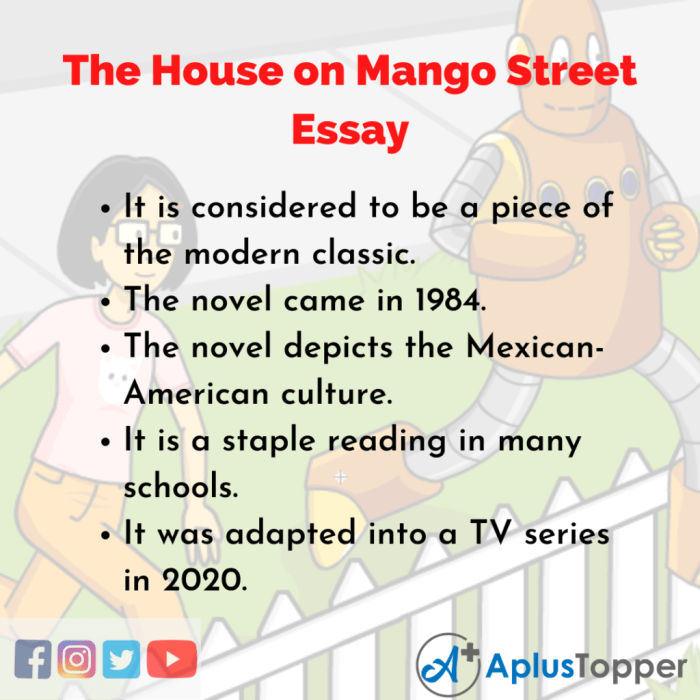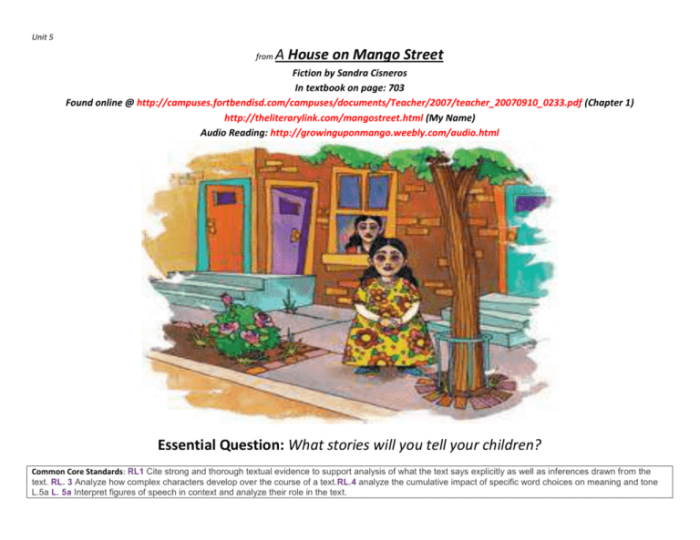Literary devices in the house on mango street – Sandra Cisneros’ “The House on Mango Street” is a literary masterpiece that showcases a diverse range of literary devices, enhancing its narrative power and emotional impact. This essay delves into the novel’s use of metaphors, similes, foreshadowing, symbolism, irony, imagery, structure, point of view, tone, and figurative language, demonstrating how these techniques contribute to the novel’s themes, character development, and overall literary value.
Literary Devices in The House on Mango Street

Sandra Cisneros’s novel, The House on Mango Street, is a coming-of-age story that explores the experiences of a young Latina girl named Esperanza Cordero. The novel is known for its use of literary devices, which enhance the narrative and convey its themes.
Metaphors
Cisneros uses metaphors to create vivid imagery and convey complex ideas. For example, Esperanza compares her house to a “broken promise” to emphasize the disappointment and sense of displacement she feels. Another metaphor is the “giant shadow” of the older girls, which represents the intimidating presence of authority and societal expectations.
Similes, Literary devices in the house on mango street
Similes are used to create comparisons that highlight specific qualities or experiences. For example, Cisneros describes the way Esperanza’s mother “scrubs the floor on her hands and knees” like “a dog begging for forgiveness.” This simile emphasizes the humility and desperation of Esperanza’s mother.
Foreshadowing
Foreshadowing is used to create suspense and anticipation. For example, the description of the neighborhood bully, Rafa, as “the one who can make you disappear” foreshadows the violence and danger that Esperanza will encounter later in the novel.
Symbolism
Symbols are objects or places that represent abstract ideas or concepts. For example, the house on Mango Street symbolizes Esperanza’s search for a sense of home and belonging. The mango tree symbolizes growth and potential.
Irony
Irony is used to create humor and emphasize themes. For example, the fact that Esperanza’s family is poor and lives in a rundown house on Mango Street is ironic considering that the neighborhood is named after a fruit that is associated with luxury and wealth.
Imagery
Cisneros uses vivid imagery to create a sensory experience for the reader. For example, the description of the “sour smell” of the house on Mango Street conveys the unpleasant and oppressive nature of Esperanza’s living conditions.
Structure
The novel is structured as a series of vignettes, each of which focuses on a different aspect of Esperanza’s life. This structure allows Cisneros to explore multiple themes and perspectives without getting bogged down in a linear narrative.
Point of View
The novel is narrated from the first-person perspective of Esperanza. This allows the reader to experience the events of the novel through Esperanza’s eyes and gain a deep understanding of her thoughts and feelings.
Tone
The tone of the novel is often nostalgic and bittersweet. Cisneros uses humor and wit to lighten the mood, but she also confronts serious issues such as poverty, racism, and sexism.
Figurative Language
Cisneros uses a wide range of figurative language devices, including metaphors, similes, foreshadowing, symbolism, irony, imagery, and hyperbole. These devices enhance the novel’s literary value and impact.
Quick FAQs
What is the significance of the house in “The House on Mango Street”?
The house symbolizes Esperanza’s search for identity and a sense of belonging. It represents both the limitations and possibilities of her life on Mango Street.
How does Cisneros use foreshadowing in the novel?
Cisneros uses foreshadowing to create suspense and build anticipation. For example, the mention of the Mango Tree at the beginning of the novel hints at the importance it will play later in the story.
What is the effect of Cisneros’ use of figurative language?
Cisneros’ use of figurative language enhances the novel’s imagery and creates a vivid setting. It also allows her to express complex emotions and ideas in a concise and evocative way.


